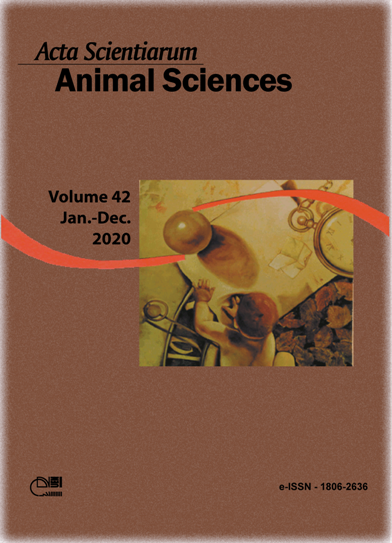Effect of in-ovo feeding of iron nanoparticles and methionine hydroxy analogue on broilers chickens small intestinal characteristics
Resumo
The experiment was conducted with 644 Ross fertilized egg by 7 treatments 4 replicates and 23 eggs in each. Seven treatments included two control with and without injection, iron sulfate, iron sulfate nanoparticles, Alimet, Alimet + iron sulfate, Alimet + iron sulfate nanoparticles. After hatching 2 mg iron nanoparticles were applied as new treatment. The highest increased in the intestinal relative weight (p < 0.05) was observed by iron+Alimet in late feeding at day old of age. Also similar trend was found in cecum and duodenum length by iron control 2 and late feeding (18 hours’ after hatching). The highest cecum length was found among all treatments by in ovo injection of iron nanoparticles in early feeding at 21 days of age (p < 0.05). Significantly increased the duodenum length was found by iron sulfate in early feeding at 42 days of age (p < 0.05). In ovo injection of Alimet in late feeding was resulted in decrease jejunum crypt depth at 21 days of age (p < 0.05). The results of this study have shown that the highest jejunum villi width and surface area were recorded in dietary iron sulfate nanoparticles in late feeding at 21 and 42 days of age (p < 0.05).
Downloads
Referências
Al-Mayah, A. A. S. (2006). Immune response of broiler chicks to DL-methionine supplementation at different ages. International Journal of Poultry Science, 5(2), 169-172.
Bedford, M. R. (1996). Interaction between ingested feed and the digestive system in poultry. Journal of Applied Poultry Research, 5(1), 86-95.
Bird, A. R., Croom Junior, W. J., Fan, Y. K., Daniel, L. R., Black, B. L., McBride, B. W., ... Taylor, I. L. (1994). Jejunal glucose absorption is enhanced by epidermal growth factor in mice. The Journal of Nutrition, 124(2), 231-240. doi: 10.1093/jn/124.2.231
Bohórquez, D. V., Bohórquez, N. E., & Ferket, P. R. (2011). Ultrastructural development of the small intestinal mucosa in the embryo and turkey poult: A light and electron microscopy study. Poultry Science, 90(4), 842-855. doi: 10.3382/ps.2010-00939
Geyra, A., Uni, Z., & Sklan, D. (2001). Enterocyte dynamics and mucosal development in the posthatch chick. Poultry Science, 80(6), 776-782.
Grimble, R. F. (2006). The effects of sulfur amino acid intake on immune function in humans. The Journal of Nutrition, 136(6), 1660S-1665S.
Gunal, M., Yayli, G., Kaya, O., Karahan, N., & Sulak, O. (2006). The effects of antibiotic growth promoter, probiotic or organic acid supplementation on performance, intestinal microflora and tissue of broilers. International Journal of Poultry Science, 5(2), 149-155.
Harvey, J. W. (2000). Microcytic anemia. In B. F. Feldman, J. G. Zinkl & N. C. Jain (Eds.), Schalm’s veterinary hematology (p. 201-220). Philadelphia, PA: Lippincott, Williams and Wilkins.
Iji, P. A., Saki, A. A., & Tivey, D. R. (2001). Intestinal development and body growth of broiler chicks on diets supplemented with non-starch polysaccharides. Animal Feed Science and Technology, 89(3), 175-188.
Imondi, A. R., & Bird, F. H. (1966). The turnover of intestinal epithelium in the chick. Poultry Science, 45(1), 142-147. doi: 10.3382/ps.0450142
Jin, S.-H., Corless, A., & Sell, J. L. (1998). Digestive system development in post-hatch poultry. World's Poultry Science Journal, 54(4), 335-345. doi: 10.1079/WPS19980023Published
Klasing, K. C. (2007). Nutrition and the immune system. British Poultry Science, 48(5), 525-537. doi: 10.1080/00071660701671336
Kogut, M. H., & Klasing, K. (2009). An immunologist’s perspective on nutrition, immunity, and infectious diseases: Introduction and overview. Journal of Applied Poultry Research, 18(1), 103-110. doi: 10.3382/japr.2008-00080
McFarlane, W. D., & Milne, H. I. (1934). Iron and copper metabolism in the developing chick embryo. Journal of Biological Chemistry, 107, 309-319.
Moran Junior, E. T. (1985). Digestion and absorption of carbohydrates in fowl and events through perinatal development. The Journal of Nutrition, 115(5), 665-674.
Richards, M. P. (1997). Trace mineral metabolism in the avian embryo. Poultry Science, 76(1), 152-164.
Statistical Analysis Software [SAS]. (2004). SAS/STAT User guide, Version 9.1.1. Cary, NC: SAS Institute Inc.
Sharma, R., Schumacher, U., Ronaasen, V., & Coates, M. (1995). Rat intestinal mucosal responses to a microbial flora and different diets. Gut, 36(2), 209-214.
Silva, A. V., Maiorka, A., Borges, S. A., Santin, E., Boleli, I. C., & Macari, M. (2007). Surface area of the tip of the enterocytes in small intestine mucosa of broilers submitted to early feed restriction and supplemented with glutamine. International Journal of Poultry Science, 6(1), 31-35. doi: 10.3923/ijps.2007.31.35
Stoltzfus, R. J. (2001). Defining iron-deficiency anemia in public health terms: a time for reflection. The Journal of Nutrition, 131(2), 565S-567S. doi: 10.1093/jn/131.2.565S
Suttle, N. F. (2010). The mineral nutrition of livestock. New York, NY: CABI Publishing.
Uni, Z., Ganot, S., & Sklan, D. (1998). Posthatch development of mucosal function in the broiler small intestine. Poultry Science, 77(1), 75-82.
Uni, Z., Noy, Y., & Sklan, D. (1999). Posthatch development of small intestinal function in the poult. Poultry Science, 78(2), 215-222.
Uni, Z., Tako, E., Gal-Garber, O., & Sklan, D. (2003). Morphological, molecular, and functional changes in the chicken small intestine of the late-term embryo. Poultry Science, 82(11), 1747-1754.
Zhu, X. Y., Zhong, T., Pandya, Y., & Joerger, R. D. (2002). 16S rRNA-based analysis of microbiota from the cecum of broiler chickens. Applied and Environmenatal Microbiology, 68(1), 124-137. doi: 10.1128/AEM.68.1.124–137.2002
DECLARAÇÃO DE ORIGINALIDADE E DIREITOS AUTORAIS
Declaro que o presente artigo é original, não tendo sido submetido à publicação em qualquer outro periódico nacional ou internacional, quer seja em parte ou em sua totalidade.
Os direitos autorais pertencem exclusivamente aos autores. Os direitos de licenciamento utilizados pelo periódico é a licença Creative Commons Attribution 4.0 (CC BY 4.0): são permitidos o compartilhamento (cópia e distribuição do material em qualqer meio ou formato) e adaptação (remix, transformação e criação de material a partir do conteúdo assim licenciado para quaisquer fins, inclusive comerciais.
Recomenda-se a leitura desse link para maiores informações sobre o tema: fornecimento de créditos e referências de forma correta, entre outros detalhes cruciais para uso adequado do material licenciado.








































